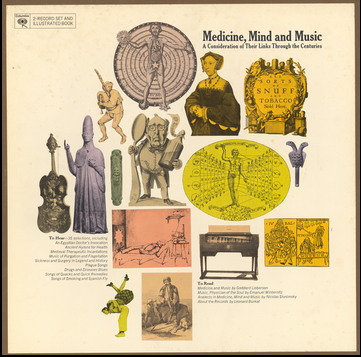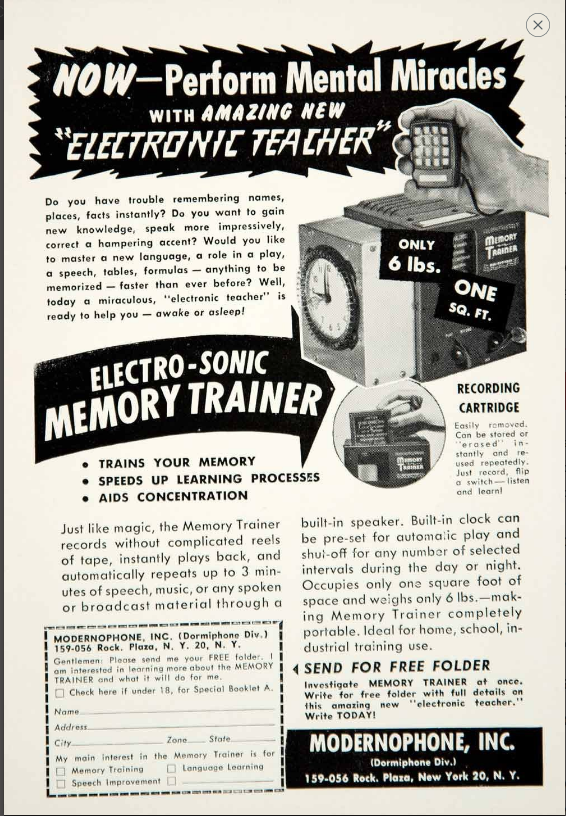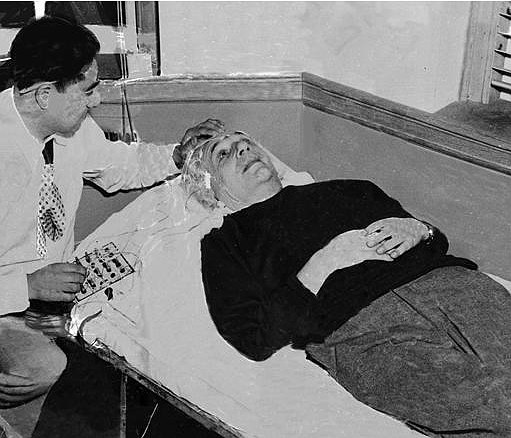Brain
Miss Intelligence
In 1968, 20-year-old Evelyn Jacoby was awarded the title of "Miss Intelligence." Or, more specifically, the "most intelligent German woman." A panel of 25 professors of psychology selected her.
Asbury Park Press - May 16, 1968

Culpeper Star-Exponent - May 10, 1968
Posted By: Alex - Wed Dec 18, 2024 -
Comments (1)
Category: Awards, Prizes, Competitions and Contests, 1960s, Brain
Bio-Control
At the 1956 National Electronics Conference in Chicago, engineer Curtiss R. Schafer predicted a future in which people would be enslaved via "bio-control."How is this possible? Schafer said that a few months after birth a surgeon would equip each child with a socket mounted under the scalp and electrodes reaching selected areas of brain tissue. A year or two later, he said, a miniature radio receiver and antenna would be plugged into the socket.
"From that time on," the speaker declared, "the child's sensory preceptions and muscular activity could be either modified or completely controlled by bio-electric signals radiated from state-controlled transmitters."
More details from the conference press release:




Time - Oct 15, 1956
Posted By: Alex - Sat Nov 12, 2022 -
Comments (1)
Category: AI, Robots and Other Automatons, Conspiracy Theories and Theorists, 1950s, Brain
Medicine, Mind and Music
Player embedded below the Tracklist. Enjoy!

Posted By: Paul - Sat Aug 06, 2022 -
Comments (0)
Category: Medicine, Music, 1970s, Brain
Jello Brainwaves
In 1974, Dr. Adrian Upton of McMaster University placed E.E.G. electrodes on a blob of lime jello and obtained positive readings. This indicated brain activity. He published his results in 1976 in the Medical Tribune.Upton was trying to demonstrate that when doctors use an E.E.G. to determine brain death, it can be difficult to obtain a perfectly flat readout, because the equipment picks up stray electrical activity from the surrounding environment. Or maybe he had discovered that jello is a sentient lifeform.
The Jell-O Gallery Museum in Le Roy, New York seems to prefer the latter conclusion. A brain-shaped jello mold on display at the museum bears the message: "A Bowl of Jell-O Gelatin and the Human Brain Have the Same Frequency of Brain Waves."

image source: Donna Goldstein, researchgate.net
More info: The Straight Dope


Wichita Eagle - Mar 8, 1976
Posted By: Alex - Mon Nov 15, 2021 -
Comments (7)
Category: Food, Jello, Experiments, 1970s, Brain
Brain worm
An Australian woman had been suffering from headaches for seven years. Doctors suspected a brain tumor. The good news was that, after operating, they found she was tumor free. The bad news was that she had a cyst full of tapeworm larvae in her brain.More info from cnn.com. Or read the full case report in the American Journal of Tropical Medicine and Hygiene.

Posted By: Alex - Tue Oct 13, 2020 -
Comments (1)
Category: Health, Medicine, Brain
The Human Performance Enhancing Robot of Dr. NakaMats
AKA Cerebrex. Invented by Dr. Yoshiro NaKaMats. It was essentially a lounger chair that was supposed to improve brain function in only 30 minutes. Details from the Arizona Republic (Sep 12, 1986):Meanwhile, customers can use it only in his sun-flooded "oyasumidokoro," or sleeping place, a nearly empty room a few floors below his laboratory, where white-coated assistants bustle around prototypes of industrial robots in various stages of development.
The inventor explains how the chair works, sort of.
"It activates your alpha brain waves by emitting ultra-high frequency electronic pulses, which in turn increase the flow of blood to the head, through the chair's pillow and foot rest," he said.

York Dispatch - July 2, 1986
You can check out a (non-embeddable) video about Cerebrex on Vimeo.
Posted By: Alex - Fri Aug 21, 2020 -
Comments (5)
Category: Inventions, 1980s, Brain
Hey, Big Brain
Posted By: Paul - Sun Jan 19, 2020 -
Comments (2)
Category: Humor, Music, 1950s, Brain
I Was a Teenage Brain Surgeon
Posted By: Paul - Mon Jun 03, 2019 -
Comments (0)
Category: Humor, Music, Surgery, Teenagers, 1950s, Brain
Electro-Sonic Memory Trainer and Dormiphone

Source of image.

Source.
A little history of the company, from THE NEW YORK TIMES for 10/24/49.

Posted By: Paul - Mon May 28, 2018 -
Comments (3)
Category: Frauds, Cons and Scams, Technology, 1950s, Brain
Einstein’s Brain Waves
Sep 1950: Dr. Alejandro Arellano of Massachusetts General Hospital took readings of Einstein's brain waves while Einstein was thinking about his theory of relativity (special or general? It doesn't say), and while he was resting. It was noted that the zigs were quite different than the zags while Einstein was thinking of his theory. Based on this finding, it was hoped that in the future it might be possible to identify geniuses by their brain waves.

Pittsburgh Press - Feb 11, 1951

Los Angeles Times - Feb 24, 1951
Posted By: Alex - Wed Jul 26, 2017 -
Comments (7)
Category: 1950s, Brain

| Who We Are |
|---|
| Alex Boese Alex is the creator and curator of the Museum of Hoaxes. He's also the author of various weird, non-fiction, science-themed books such as Elephants on Acid and Psychedelic Apes. Paul Di Filippo Paul has been paid to put weird ideas into fictional form for over thirty years, in his career as a noted science fiction writer. He has recently begun blogging on many curious topics with three fellow writers at The Inferior 4+1. Contact Us |




